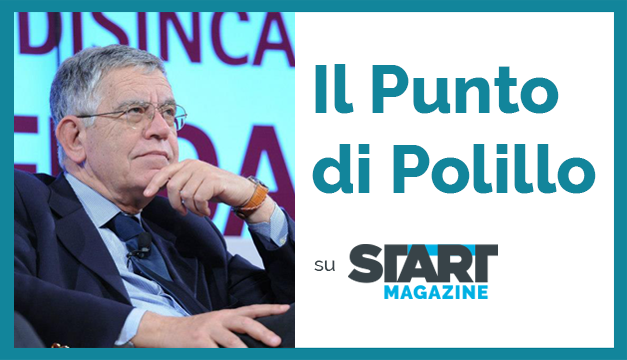Because I see more lights than shadows in the future of the Italian economy

How will the Italian economy go? Gianfranco Polillo's analysis
There is a new letter which, with its symbolism, disturbs the sleep of economists all over the world: the "K". Which does not mean "crisis", from Krisis, in German. Nor does it reflect the book by Massimo Cacciari ( Krisis, Essay on the crisis of negative thinking from Nietzsche to Wittgenstein ) which in the mid-1970s fueled a great discussion. It does not even concern the “crisis”, in the common sense of the term, but refers to the characteristics of a recovery, which is already underway, but whose forms are very different from the past. Not only different but more worrying.
From this point of view, that letter risks becoming the symbol of growing inequalities: between monetary areas, within them between the countries that compose them, in individual economies between sectors, companies and workers. It wouldn't be the first time, one might say. The economic crisis has always led to changes during which some have moved forward, more accelerated, while others have fallen behind. The 2007 crisis, due to the bankruptcy of Lehman Brothers, was a "V". Fall and recovery in rapid succession. A sort of depression immediately filled by the expansionary policies of the central banks.
Except that for some countries, such as Italy or Greece, the subsequent fall in GDP, due to the sovereign debt crisis, transformed that original form over time: from "V" to "W". The initial fall, the temporary return to a coveted normality, then the subsequent descent to hell. With the final result that, before the outbreak of the pandemic, neither of the two, unlike the other European countries, had recovered the income levels of 2007.
From this point of view, considering the medium-term dimension – the ten years and more that have elapsed since the start of the American crisis – for Italy and Greece, in particular, the letter that best identified the relative situation was that of the "U". Considering that the initial crisis was followed by a longer period of relative stagnation, therefore a recovery that has not yet recovered the lost ground.
Above all, Italy has therefore entered the infernal circle of the pandemic starting from a position of weakness. Will he be able to regain lost ground? This is the big question that dominates the debate today. The theses in this regard are conflicting. The use of the letter "k" is the proof of this. For example, the European Fiscal Board, the body that deals with public finance in Brussels and which some would like to replace, the European Commission itself, in the controls on the budgets of the individual States, comes to this conclusion.
According to his latest report a fortnight ago, Italy would be the only Eurozone country to lag behind. That is, unlike the other partners, it would not reach the income levels of 2019, in 2022. This is mainly due to the weak performance of last year. How many troubles, dear "People's Advocate". The Financial Times , on the other hand, has recently shown greater optimism, which evidently does not agree with the gloomy analyzes of Marco Travaglio. Perhaps it will not be the exclusive merit of Mario Draghi, but the fact is that the economy, since the beginning of the year, has strongly restarted, with an extra gear.
In April – writes the English daily – exports had grown by 6 percent, compared to January 2020. “The strongest growth rate in the whole Eurozone, when compared to 1 percent in France and Germany”. Especially thanks to the companies that had intensified their presence on the network. In 2015, only one in ten companies thought of using digital technology. Since then, progress has been constant and the Italian presence in that large virtual shop, created by the internet, has become massive. Which explains why in the first quarter of this year Italy's gross national income grew by 0.1 percent, while that of the Eurozone decreased by 0.3.
It is again a profile linked to the “K” factor. Some sectors of the economy – those related to the use of technology – are growing rapidly. On the other hand, those who require physical presence – catering, tourism, leisure and so on – have not yet departed or have not withstood the lockdown, despite public aid. The same trend is unfortunately manifested in the employment sector. There is a shortage of employees in many production sectors, while the specter of unemployment looms in others. There are those who would like to stop all this, crystallizing the present in the generosity of a block of layoffs decreed by law. Maybe it could. It would be better, then, to delete the letter "K" from the alphabet.
But in the end – legitimate question – what will happen? Of course, it doesn't make much sense to play with the crystal ball. Prometeia's latest forecasts, however, give hope. There is talk of a possible growth "double compared to the previous 10 years". And a GDP that already at the end of the year will be equal to 5.3 per cent, against the 4.2 indicated by the Government and an average of 4.3 for the Eurozone. We would thus have fully recovered the negative gap predicted by the European Fiscal Board. Of course, in these cases, it is always good to cross your fingers. But as the bartender from Ceccano, great Nino Manfredi, said: "if only it was the vorta bbona!"
This is a machine translation from Italian language of a post published on Start Magazine at the URL https://www.startmag.it/economia/perche-vedo-piu-luci-che-ombre-nel-futuro-delleconomia-italiana/ on Wed, 07 Jul 2021 08:23:09 +0000.
